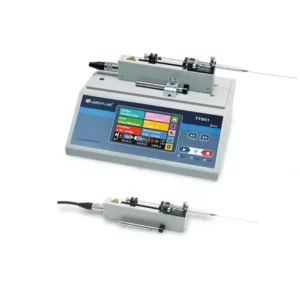Lab syringe pumps are essential tools in scientific research, chemical analysis, and various laboratory applications. These pumps provide accurate and controlled fluid dispensing, allowing researchers to deliver precise volumes of liquids or gases. In this article, we will explore the inner workings of a lab syringe pump, highlighting its components, operating principles, and the advantages it offers in laboratory settings.
Understanding the Lab Syringe Pump
- Components: A lab syringe pump typically consists of a syringe, a drive mechanism, a control interface, and a power source. The syringe serves as the reservoir for the fluid being dispensed, while the drive mechanism provides the necessary force to move the plunger within the syringe barrel. The control interface allows users to set the desired flow rate, volume, and other parameters, while the power source provides the energy needed to drive the pump.
- Operating Principles: Lab syringe pumps operate on the principle of positive displacement. By applying a controlled force to the plunger, the pump moves the fluid within the syringe at a predetermined rate. This allows for precise and repeatable dispensing, ensuring accurate volumes are delivered.
Pump Mechanism and Operation
- Motorized Drive:Lab syringe pumps are typically motorized, with the drive mechanism consisting of a stepper motor or a servo motor. The motor generates rotational motion that is converted into linear movement using a lead screw or a gear mechanism.
- Syringe Attachment:The syringe is securely attached to the pump using a syringe holder or a clamp mechanism. The attachment ensures a tight seal between the syringe barrel and the pump, preventing leakage and maintaining the integrity of the fluid being dispensed.
- Plunger Movement:The motorized drive mechanism translates the rotational motion into linear movement, causing the plunger to advance or retract within the syringe barrel. As the plunger moves, it pushes or pulls the fluid inside the syringe, resulting in controlled dispensing.
- Control Interface:Lab syringe pumps are equipped with a control interface that allows users to set parameters such as flow rate, volume, and dispensing time. The interface may include a display screen, buttons, and a keypad or a touchscreen for user interaction. Advanced models may also offer features like programmable sequences and remote control options.
Advantages and Applications of Lab Syringe Pumps
- Precise Fluid Dispensing:Lab syringe pumps offer exceptional precision, allowing researchers to dispense fluids in precise volumes with high accuracy. This level of control is critical in applications such as drug delivery, chemical analysis, microfluidics, and sample dilution, where even small deviations can significantly impact results.
- Programmability and Automation:Many lab syringe pumps feature programmable capabilities, enabling users to create complex dispensing sequences, flow profiles, or multi-step operations. This automation reduces human error, enhances reproducibility, and increases efficiency in laboratory workflows.
- Versatility and Compatibility:Lab syringe pumps are compatible with a wide range of fluids, including aqueous solutions, organic solvents, viscous substances, gases, and suspensions. Their versatility allows for diverse applications in fields such as pharmaceutical research, biotechnology, chemistry, and materials science.
- Integration with Analytical Instruments:Lab syringe pumps can be integrated with various analytical instruments, such as chromatography systems, spectrometers, or automated sampling devices. This integration enables precise sample injection, calibration standards preparation, and continuous flow processes, enhancing the accuracy and reliability of analytical measurements.
Lab syringe pumps provide researchers with a reliable and precise fluid dispensing solution for a wide range of laboratory applications. By employing positive displacement principles and motorized drive mechanisms, these pumps offer accurate and repeatable fluid delivery. With their programmability, compatibility, and integration capabilities, lab syringe pumps enhance experimental control, increase productivity, and contribute to the advancement of scientific research and discovery.

